Abstract
Adhesion of cancer cells to vascular endothelium is an important step in haematogenous metastasis of cancer. A human hepatocellular carcinoma cell line, HepG2, strongly adheres to human umbilical vein endothelial cells (HUVECs) through the interaction of E-selectin and its carbohydrate ligand sialyl Lewis X. In this study, we investigated alteration in integrin expression on HepG2 cells, which follows the selectin-mediated initial adhesion of HepG2 cells to HUVECs. Expression of alpha2beta1 integrin was markedly increased when the HepG2 cells adhered to HUVECs. Among the tested cytokines that are known to be produced by endothelial cells, recombinant hepatocyte growth factor (rHGF) could replace the effect of HUVECs, and a similar increase in integrin expression was observed by the addition of 20 ng ml-1 rHGF to HepG2. The increment of alpha2beta1 integrin expression was significantly inhibited by anti-HGF neutralizing antibody treatment. HepG2 cells expressed alpha2, alpha6, beta1, and beta4 integrin subunits, but expression of integrins other than alpha2beta1 was not affected by the rHGF treatment. The rHGF treatment of HepG2 cells resulted in augmented adhesion to immobilized collagen. This augmentation in adhesion to collagen was completely blocked by the addition of anti-alpha2- or anti-beta1-integrin antibody. In double-chamber chemoinvasion experiments, transmigration of the HepG2 cells through extracellular matrix (ECM) gel was significantly accelerated by co-cultivation with HUVECs. A similar level of enhancement in transmigration activity of the cancer cells was observed by the addition of rHGF. Our interpretation of the results described above is that the cancer cells received stimulation from cytokines, such as HGF, presented by vascular endothelial cells, following the initial adhesion of cancer cells via selectins. This resulted in the secondary increment in the expression of cell adhesion molecules, such as the alpha2beta1 integrin, and led to the augmented adhesive activities of cancer cells towards extracellular matrices at vascular walls. We suggest that this sequence of events is involved in the facilitated migration of some cancer cells to extravascular tissues.
Full text
PDF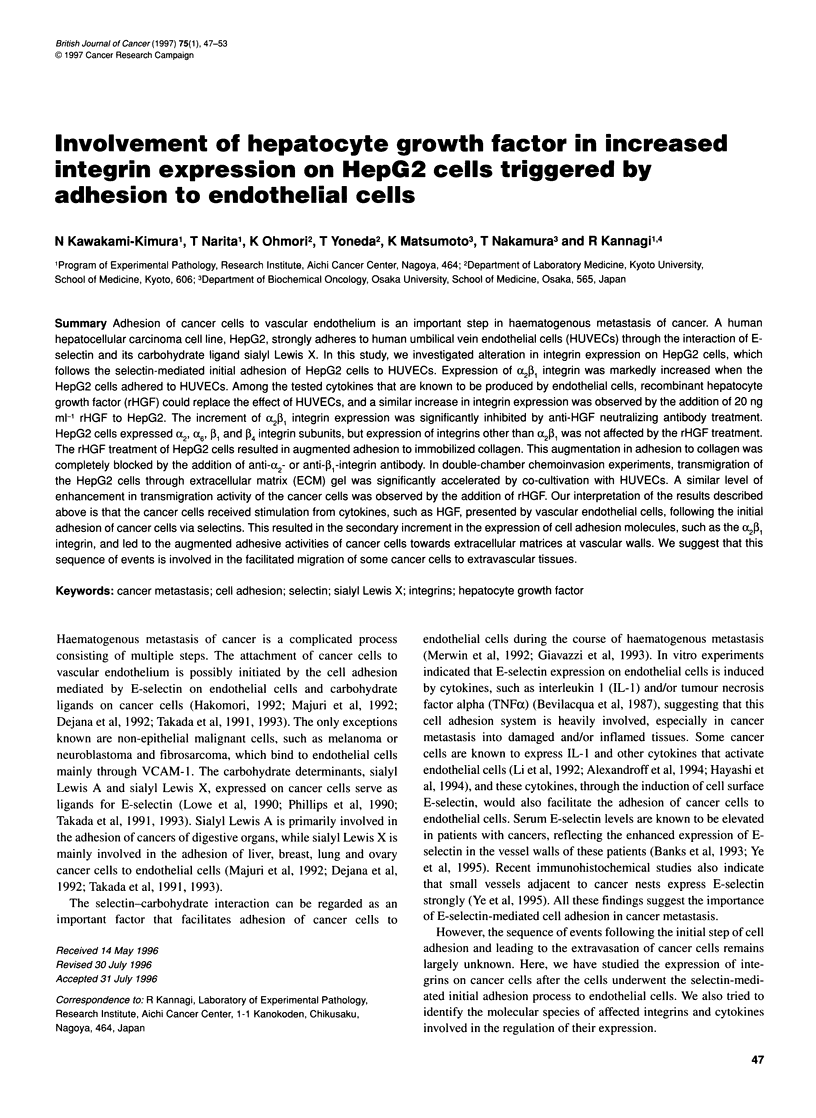
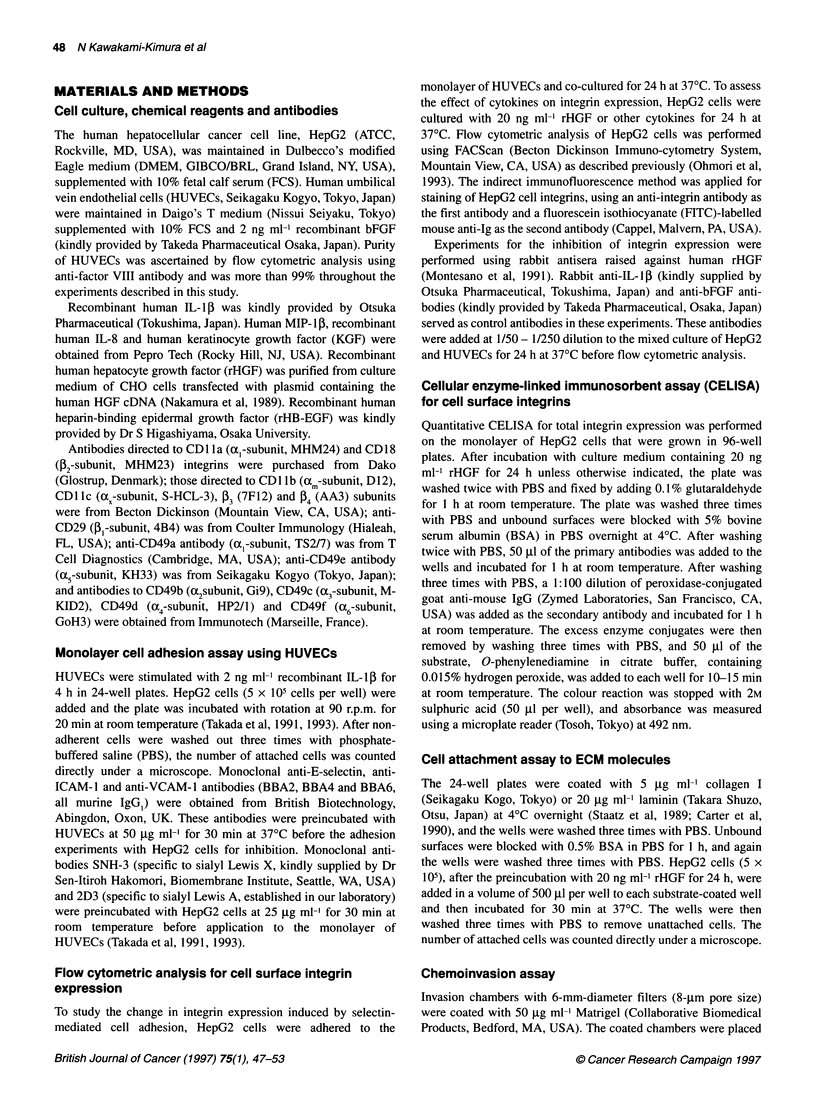
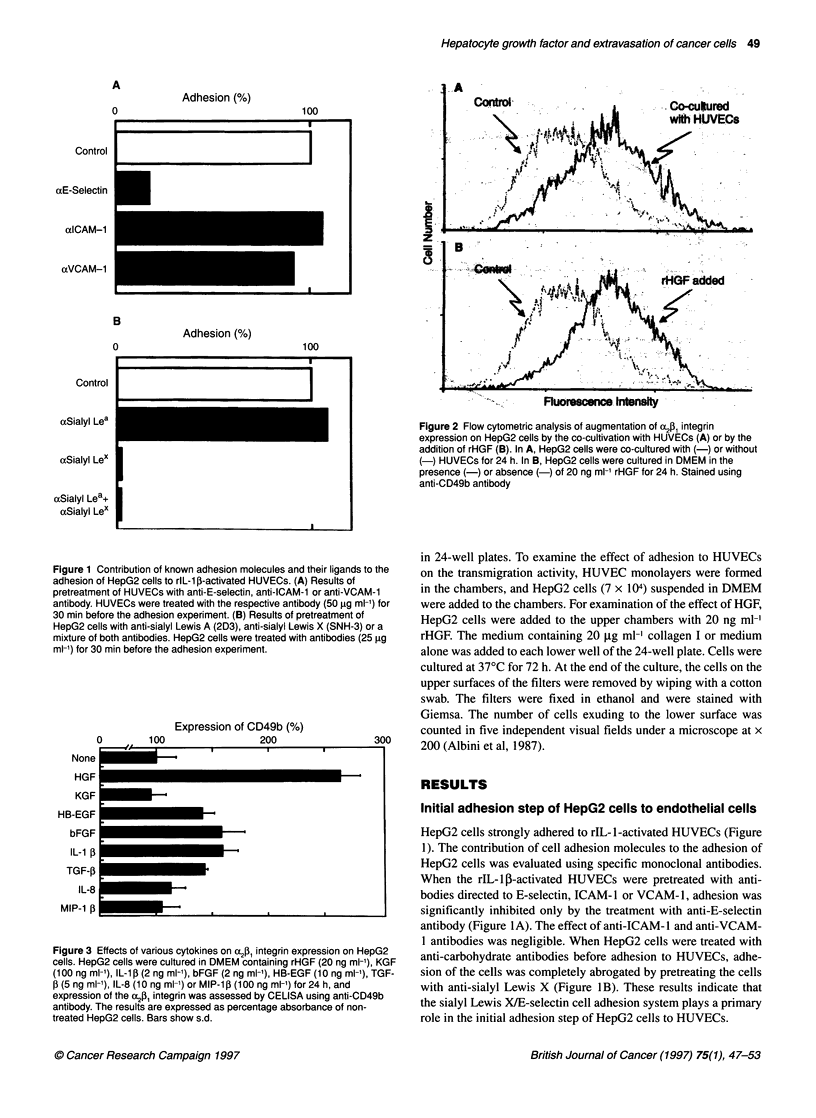
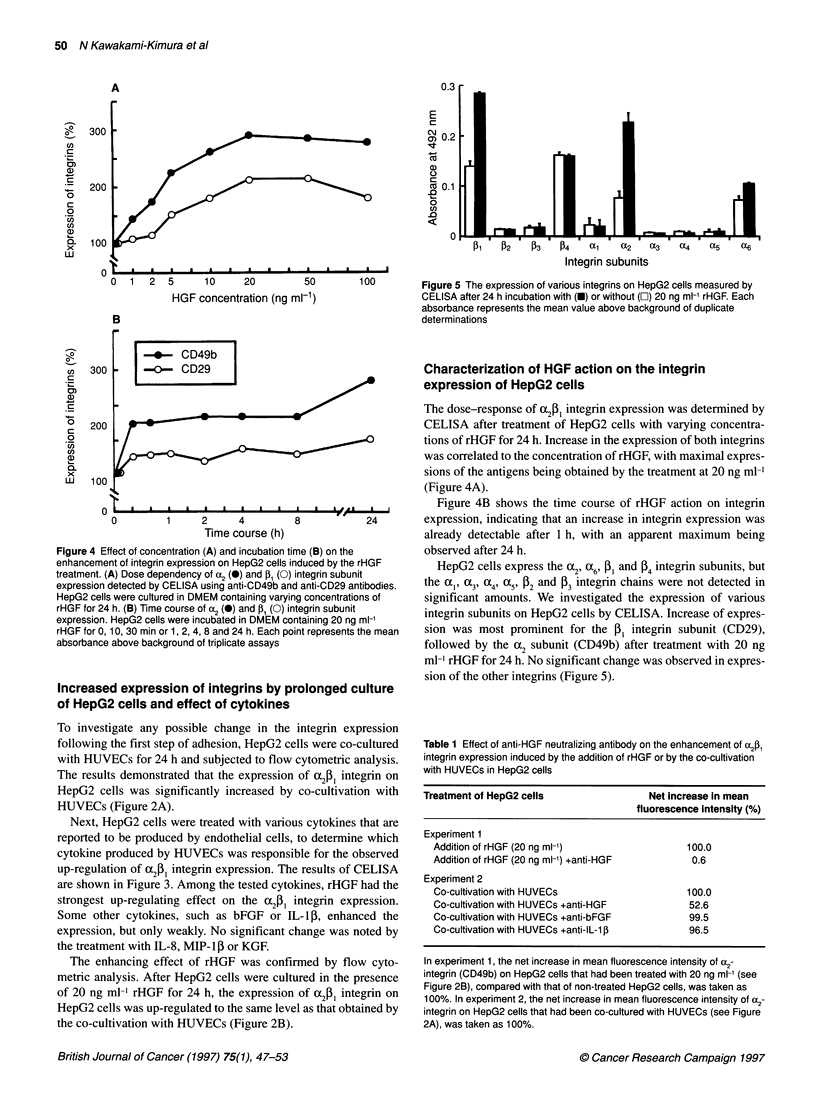
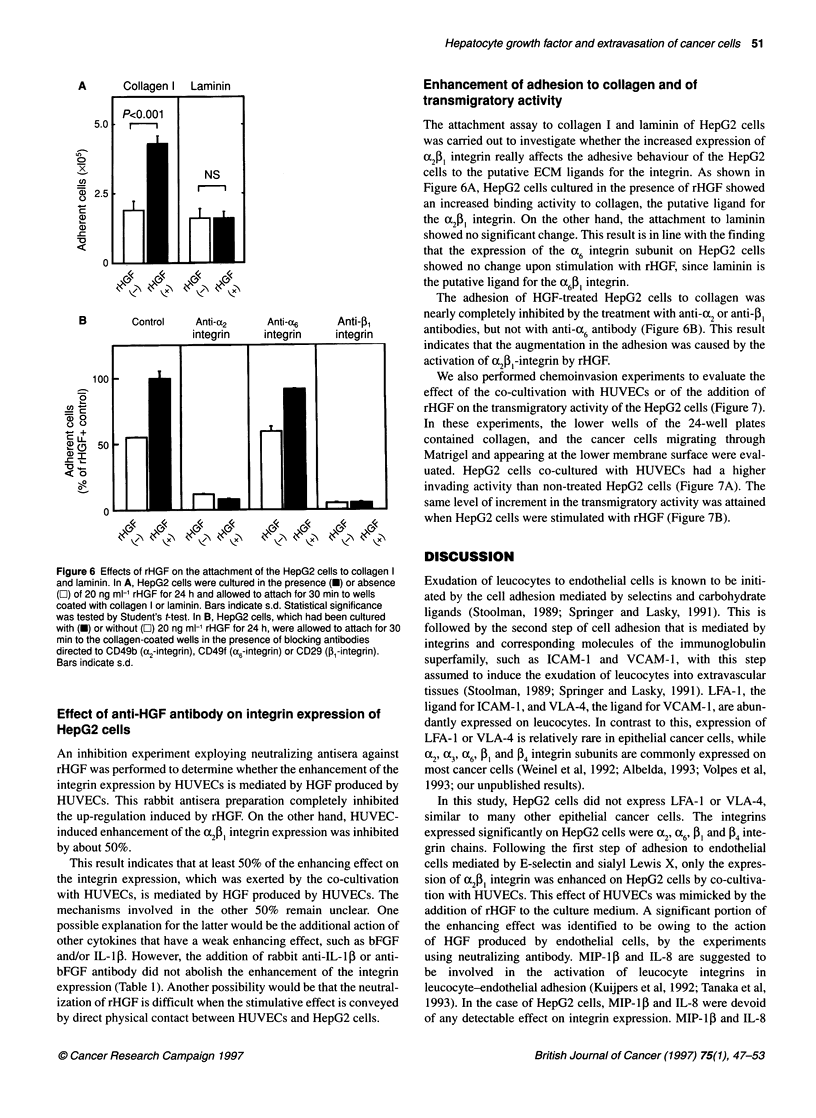
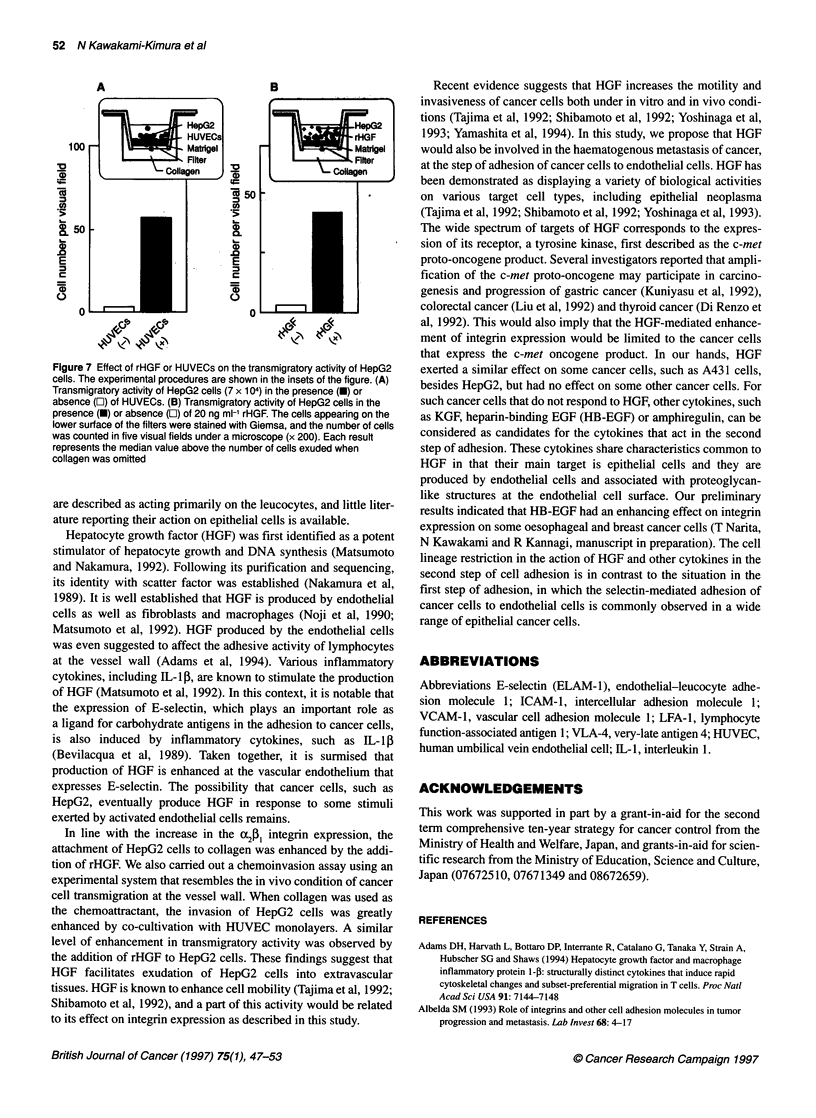
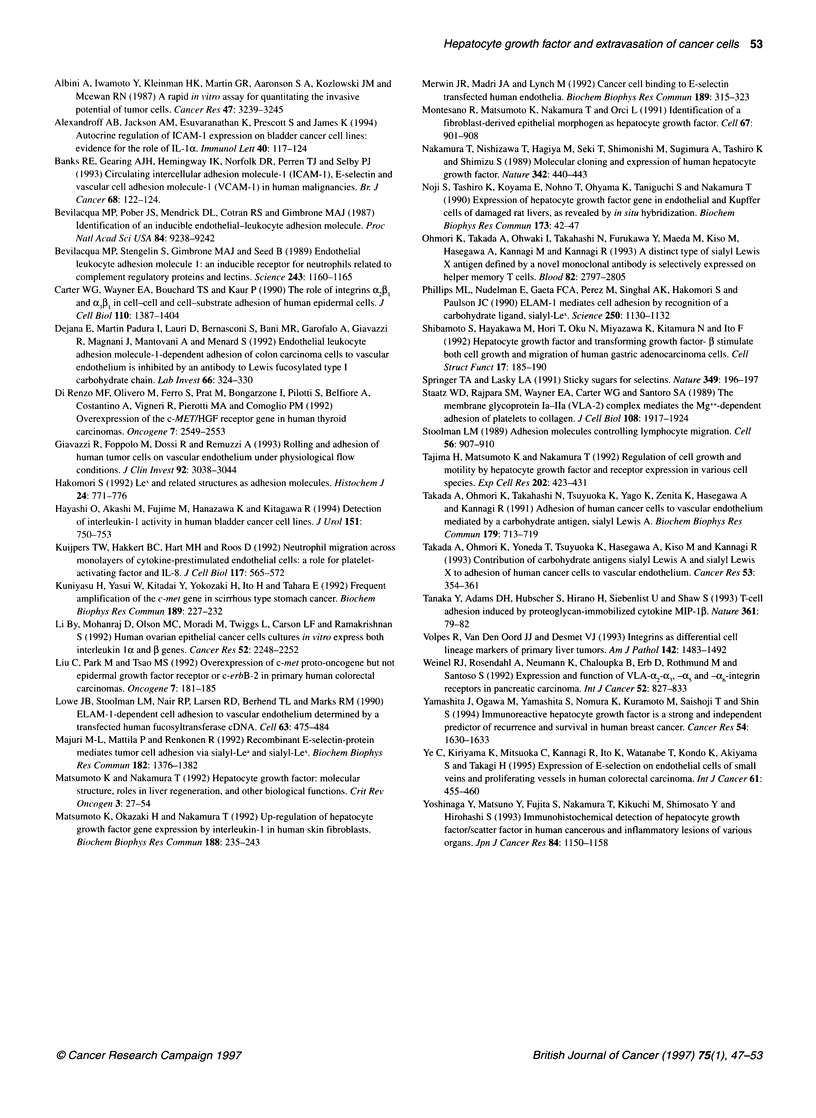
Selected References
These references are in PubMed. This may not be the complete list of references from this article.
- Adams D. H., Harvath L., Bottaro D. P., Interrante R., Catalano G., Tanaka Y., Strain A., Hubscher S. G., Shaw S. Hepatocyte growth factor and macrophage inflammatory protein 1 beta: structurally distinct cytokines that induce rapid cytoskeletal changes and subset-preferential migration in T cells. Proc Natl Acad Sci U S A. 1994 Jul 19;91(15):7144–7148. doi: 10.1073/pnas.91.15.7144. [DOI] [PMC free article] [PubMed] [Google Scholar]
- Albelda S. M. Role of integrins and other cell adhesion molecules in tumor progression and metastasis. Lab Invest. 1993 Jan;68(1):4–17. [PubMed] [Google Scholar]
- Albini A., Iwamoto Y., Kleinman H. K., Martin G. R., Aaronson S. A., Kozlowski J. M., McEwan R. N. A rapid in vitro assay for quantitating the invasive potential of tumor cells. Cancer Res. 1987 Jun 15;47(12):3239–3245. [PubMed] [Google Scholar]
- Alexandroff A. B., Jackson A. M., Esuvaranathan K., Prescott S., James K. Autocrine regulation of ICAM-1 expression on bladder cancer cell lines: evidence for the role of IL-1 alpha. Immunol Lett. 1994 May;40(2):117–124. doi: 10.1016/0165-2478(94)90182-1. [DOI] [PubMed] [Google Scholar]
- Banks R. E., Gearing A. J., Hemingway I. K., Norfolk D. R., Perren T. J., Selby P. J. Circulating intercellular adhesion molecule-1 (ICAM-1), E-selectin and vascular cell adhesion molecule-1 (VCAM-1) in human malignancies. Br J Cancer. 1993 Jul;68(1):122–124. doi: 10.1038/bjc.1993.298. [DOI] [PMC free article] [PubMed] [Google Scholar]
- Bevilacqua M. P., Pober J. S., Mendrick D. L., Cotran R. S., Gimbrone M. A., Jr Identification of an inducible endothelial-leukocyte adhesion molecule. Proc Natl Acad Sci U S A. 1987 Dec;84(24):9238–9242. doi: 10.1073/pnas.84.24.9238. [DOI] [PMC free article] [PubMed] [Google Scholar]
- Bevilacqua M. P., Stengelin S., Gimbrone M. A., Jr, Seed B. Endothelial leukocyte adhesion molecule 1: an inducible receptor for neutrophils related to complement regulatory proteins and lectins. Science. 1989 Mar 3;243(4895):1160–1165. doi: 10.1126/science.2466335. [DOI] [PubMed] [Google Scholar]
- Carter W. G., Wayner E. A., Bouchard T. S., Kaur P. The role of integrins alpha 2 beta 1 and alpha 3 beta 1 in cell-cell and cell-substrate adhesion of human epidermal cells. J Cell Biol. 1990 Apr;110(4):1387–1404. doi: 10.1083/jcb.110.4.1387. [DOI] [PMC free article] [PubMed] [Google Scholar]
- Dejana E., Martin-Padura I., Lauri D., Bernasconi S., Bani M. R., Garofalo A., Giavazzi R., Magnani J., Mantovani A., Menard S. Endothelial leukocyte adhesion molecule-1-dependent adhesion of colon carcinoma cells to vascular endothelium is inhibited by an antibody to Lewis fucosylated type I carbohydrate chain. Lab Invest. 1992 Mar;66(3):324–330. [PubMed] [Google Scholar]
- Di Renzo M. F., Olivero M., Ferro S., Prat M., Bongarzone I., Pilotti S., Belfiore A., Costantino A., Vigneri R., Pierotti M. A. Overexpression of the c-MET/HGF receptor gene in human thyroid carcinomas. Oncogene. 1992 Dec;7(12):2549–2553. [PubMed] [Google Scholar]
- Giavazzi R., Foppolo M., Dossi R., Remuzzi A. Rolling and adhesion of human tumor cells on vascular endothelium under physiological flow conditions. J Clin Invest. 1993 Dec;92(6):3038–3044. doi: 10.1172/JCI116928. [DOI] [PMC free article] [PubMed] [Google Scholar]
- Hakomori S. Le(X) and related structures as adhesion molecules. Histochem J. 1992 Nov;24(11):771–776. doi: 10.1007/BF01046348. [DOI] [PubMed] [Google Scholar]
- Hayashi O., Akashi M., Fujime M., Hanazawa K., Kitagawa R. Detection of interleukin-1 activity in human bladder cancer cell lines. J Urol. 1994 Mar;151(3):750–753. doi: 10.1016/s0022-5347(17)35080-2. [DOI] [PubMed] [Google Scholar]
- Kuijpers T. W., Hakkert B. C., Hart M. H., Roos D. Neutrophil migration across monolayers of cytokine-prestimulated endothelial cells: a role for platelet-activating factor and IL-8. J Cell Biol. 1992 May;117(3):565–572. doi: 10.1083/jcb.117.3.565. [DOI] [PMC free article] [PubMed] [Google Scholar]
- Kuniyasu H., Yasui W., Kitadai Y., Yokozaki H., Ito H., Tahara E. Frequent amplification of the c-met gene in scirrhous type stomach cancer. Biochem Biophys Res Commun. 1992 Nov 30;189(1):227–232. doi: 10.1016/0006-291x(92)91548-5. [DOI] [PubMed] [Google Scholar]
- Li B. Y., Mohanraj D., Olson M. C., Moradi M., Twiggs L., Carson L. F., Ramakrishnan S. Human ovarian epithelial cancer cells cultures in vitro express both interleukin 1 alpha and beta genes. Cancer Res. 1992 Apr 15;52(8):2248–2252. [PubMed] [Google Scholar]
- Liu C., Park M., Tsao M. S. Overexpression of c-met proto-oncogene but not epidermal growth factor receptor or c-erbB-2 in primary human colorectal carcinomas. Oncogene. 1992 Jan;7(1):181–185. [PubMed] [Google Scholar]
- Lowe J. B., Stoolman L. M., Nair R. P., Larsen R. D., Berhend T. L., Marks R. M. ELAM-1--dependent cell adhesion to vascular endothelium determined by a transfected human fucosyltransferase cDNA. Cell. 1990 Nov 2;63(3):475–484. doi: 10.1016/0092-8674(90)90444-j. [DOI] [PubMed] [Google Scholar]
- Majuri M. L., Mattila P., Renkonen R. Recombinant E-selectin-protein mediates tumor cell adhesion via sialyl-Le(a) and sialyl-Le(x). Biochem Biophys Res Commun. 1992 Feb 14;182(3):1376–1382. doi: 10.1016/0006-291x(92)91885-t. [DOI] [PubMed] [Google Scholar]
- Matsumoto K., Nakamura T. Hepatocyte growth factor: molecular structure, roles in liver regeneration, and other biological functions. Crit Rev Oncog. 1992;3(1-2):27–54. [PubMed] [Google Scholar]
- Matsumoto K., Okazaki H., Nakamura T. Up-regulation of hepatocyte growth factor gene expression by interleukin-1 in human skin fibroblasts. Biochem Biophys Res Commun. 1992 Oct 15;188(1):235–243. doi: 10.1016/0006-291x(92)92375-8. [DOI] [PubMed] [Google Scholar]
- Merwin J. R., Madri J. A., Lynch M. Cancer cell binding to E-selectin transfected human endothelia. Biochem Biophys Res Commun. 1992 Nov 30;189(1):315–323. doi: 10.1016/0006-291x(92)91560-d. [DOI] [PubMed] [Google Scholar]
- Montesano R., Matsumoto K., Nakamura T., Orci L. Identification of a fibroblast-derived epithelial morphogen as hepatocyte growth factor. Cell. 1991 Nov 29;67(5):901–908. doi: 10.1016/0092-8674(91)90363-4. [DOI] [PubMed] [Google Scholar]
- Nakamura T., Nishizawa T., Hagiya M., Seki T., Shimonishi M., Sugimura A., Tashiro K., Shimizu S. Molecular cloning and expression of human hepatocyte growth factor. Nature. 1989 Nov 23;342(6248):440–443. doi: 10.1038/342440a0. [DOI] [PubMed] [Google Scholar]
- Noji S., Tashiro K., Koyama E., Nohno T., Ohyama K., Taniguchi S., Nakamura T. Expression of hepatocyte growth factor gene in endothelial and Kupffer cells of damaged rat livers, as revealed by in situ hybridization. Biochem Biophys Res Commun. 1990 Nov 30;173(1):42–47. doi: 10.1016/s0006-291x(05)81018-6. [DOI] [PubMed] [Google Scholar]
- Ohmori K., Takada A., Ohwaki I., Takahashi N., Furukawa Y., Maeda M., Kiso M., Hasegawa A., Kannagi M., Kannagi R. A distinct type of sialyl Lewis X antigen defined by a novel monoclonal antibody is selectively expressed on helper memory T cells. Blood. 1993 Nov 1;82(9):2797–2805. [PubMed] [Google Scholar]
- Phillips M. L., Nudelman E., Gaeta F. C., Perez M., Singhal A. K., Hakomori S., Paulson J. C. ELAM-1 mediates cell adhesion by recognition of a carbohydrate ligand, sialyl-Lex. Science. 1990 Nov 23;250(4984):1130–1132. doi: 10.1126/science.1701274. [DOI] [PubMed] [Google Scholar]
- Shibamoto S., Hayakawa M., Hori T., Oku N., Miyazawa K., Kitamura N., Ito F. Hepatocyte growth factor and transforming growth factor-beta stimulate both cell growth and migration of human gastric adenocarcinoma cells. Cell Struct Funct. 1992 Jun;17(3):185–190. doi: 10.1247/csf.17.185. [DOI] [PubMed] [Google Scholar]
- Springer T. A., Lasky L. A. Cell adhesion. Sticky sugars for selectins. Nature. 1991 Jan 17;349(6306):196–197. doi: 10.1038/349196a0. [DOI] [PubMed] [Google Scholar]
- Staatz W. D., Rajpara S. M., Wayner E. A., Carter W. G., Santoro S. A. The membrane glycoprotein Ia-IIa (VLA-2) complex mediates the Mg++-dependent adhesion of platelets to collagen. J Cell Biol. 1989 May;108(5):1917–1924. doi: 10.1083/jcb.108.5.1917. [DOI] [PMC free article] [PubMed] [Google Scholar]
- Stoolman L. M. Adhesion molecules controlling lymphocyte migration. Cell. 1989 Mar 24;56(6):907–910. doi: 10.1016/0092-8674(89)90620-x. [DOI] [PubMed] [Google Scholar]
- Tajima H., Matsumoto K., Nakamura T. Regulation of cell growth and motility by hepatocyte growth factor and receptor expression in various cell species. Exp Cell Res. 1992 Oct;202(2):423–431. doi: 10.1016/0014-4827(92)90095-p. [DOI] [PubMed] [Google Scholar]
- Takada A., Ohmori K., Takahashi N., Tsuyuoka K., Yago A., Zenita K., Hasegawa A., Kannagi R. Adhesion of human cancer cells to vascular endothelium mediated by a carbohydrate antigen, sialyl Lewis A. Biochem Biophys Res Commun. 1991 Sep 16;179(2):713–719. doi: 10.1016/0006-291x(91)91875-d. [DOI] [PubMed] [Google Scholar]
- Takada A., Ohmori K., Yoneda T., Tsuyuoka K., Hasegawa A., Kiso M., Kannagi R. Contribution of carbohydrate antigens sialyl Lewis A and sialyl Lewis X to adhesion of human cancer cells to vascular endothelium. Cancer Res. 1993 Jan 15;53(2):354–361. [PubMed] [Google Scholar]
- Tanaka Y., Adams D. H., Hubscher S., Hirano H., Siebenlist U., Shaw S. T-cell adhesion induced by proteoglycan-immobilized cytokine MIP-1 beta. Nature. 1993 Jan 7;361(6407):79–82. doi: 10.1038/361079a0. [DOI] [PubMed] [Google Scholar]
- Volpes R., van den Oord J. J., Desmet V. J. Integrins as differential cell lineage markers of primary liver tumors. Am J Pathol. 1993 May;142(5):1483–1492. [PMC free article] [PubMed] [Google Scholar]
- Weinel R. J., Rosendahl A., Neumann K., Chaloupka B., Erb D., Rothmund M., Santoso S. Expression and function of VLA-alpha 2, -alpha 3, -alpha 5 and -alpha 6-integrin receptors in pancreatic carcinoma. Int J Cancer. 1992 Nov 11;52(5):827–833. doi: 10.1002/ijc.2910520526. [DOI] [PubMed] [Google Scholar]
- Yamashita J., Ogawa M., Yamashita S., Nomura K., Kuramoto M., Saishoji T., Shin S. Immunoreactive hepatocyte growth factor is a strong and independent predictor of recurrence and survival in human breast cancer. Cancer Res. 1994 Apr 1;54(7):1630–1633. [PubMed] [Google Scholar]
- Ye C., Kiriyama K., Mistuoka C., Kannagi R., Ito K., Watanabe T., Kondo K., Akiyama S., Takagi H. Expression of E-selectin on endothelial cells of small veins in human colorectal cancer. Int J Cancer. 1995 May 16;61(4):455–460. doi: 10.1002/ijc.2910610404. [DOI] [PubMed] [Google Scholar]
- Yoshinaga Y., Matsuno Y., Fujita S., Nakamura T., Kikuchi M., Shimosato Y., Hirohashi S. Immunohistochemical detection of hepatocyte growth factor/scatter factor in human cancerous and inflammatory lesions of various organs. Jpn J Cancer Res. 1993 Nov;84(11):1150–1158. doi: 10.1111/j.1349-7006.1993.tb02815.x. [DOI] [PMC free article] [PubMed] [Google Scholar]


